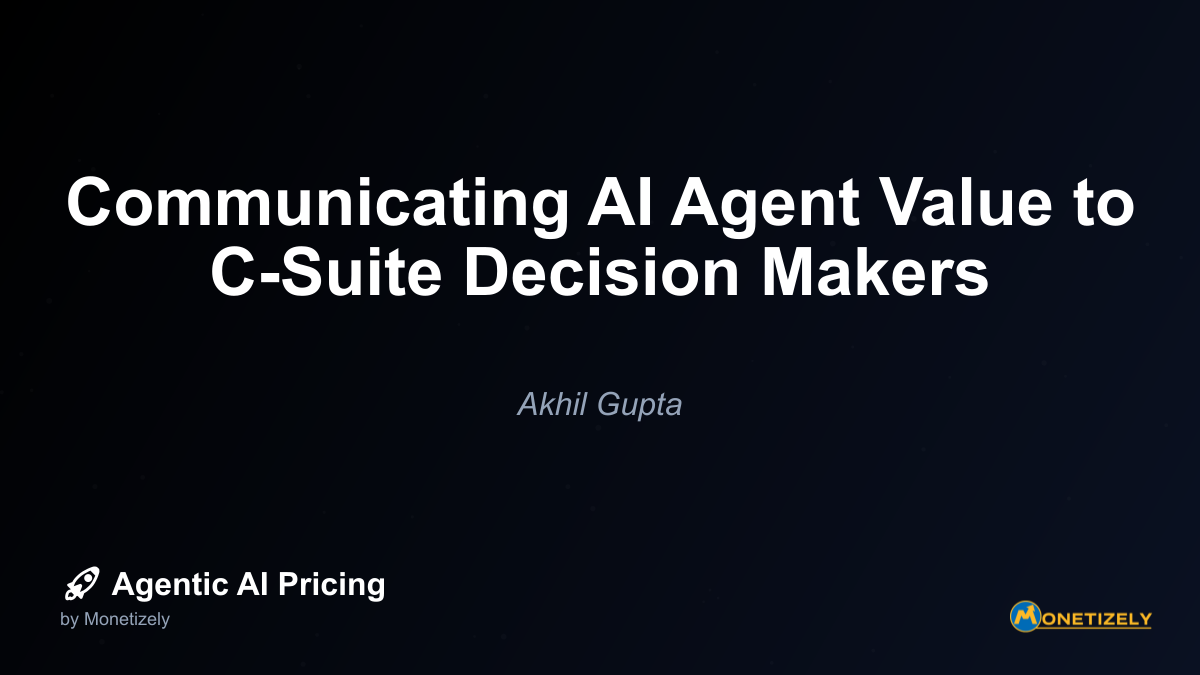· Akhil Gupta · Communication & Messaging · 7 min read
Creating Urgency Without Discounting: AI Pricing Psychology
AI and SaaS Pricing Masterclass
Learn the art of strategic pricing directly from industry experts. Our comprehensive course provides frameworks and methodologies for optimizing your pricing strategy in the evolving AI landscape. Earn a professional certification that can be imported directly to your LinkedIn profile.

4. Exclusive Beta Access Programs
For AI companies with emerging capabilities, creating a structured beta program with limited slots creates natural urgency:
- “Only accepting 10 companies for our advanced NLP feature beta”
- “Beta testing our new predictive analytics module with 5 select partners”
- “Early access program closing after we reach capacity”
This approach is particularly effective for AI solutions with genuinely innovative capabilities. The exclusivity creates urgency while the beta framing justifies the limited availability without suggesting discount requirements.
A study by behavioral economists examining AI adoption patterns found that exclusive beta access programs generated 3.4x more urgency than traditional limited-time discounts, while preserving price integrity.
Communicating Urgency Effectively: Messaging Frameworks
The way urgency is communicated significantly impacts its effectiveness. For sophisticated AI solutions, certain communication frameworks produce better results than others:
The Opportunity Gap Framework
This framework emphasizes the expanding difference between companies that implement AI solutions now versus those that delay:
- Identify the current state and its limitations
- Illustrate the improved future state with implementation
- Demonstrate how the gap between these states widens over time
- Quantify the cumulative opportunity cost of delay
Example: “Organizations implementing our predictive maintenance AI today are reducing downtime by 37%. This advantage compounds monthly, creating an expanding competitive gap that becomes increasingly difficult to close.”
The Resource Allocation Reality Framework
This approach transparently communicates genuine resource constraints:
- Acknowledge the finite nature of implementation resources
- Explain the company’s capacity planning approach
- Detail the specific limitations (development hours, specialized expertise)
- Provide a clear timeline for when these resources will be allocated
Example: “Our AI customization team consists of 12 specialists who can manage 4 enterprise implementations simultaneously. We currently have 2 slots remaining for Q3, after which new projects will be scheduled for Q1 next year.”
This framework creates urgency through transparency rather than artificial scarcity, building trust while motivating timely decisions.
The Future-Proofing Framework
This approach focuses on how current implementation provides ongoing advantages:
- Highlight upcoming changes in the market or technology
- Explain how early implementation creates adaptability advantages
- Detail specific benefits that accumulate for early adopters
- Contrast with the increasing challenges of late adoption
Example: “Companies implementing our AI decision framework now will automatically benefit from our quarterly algorithm improvements. Each update compounds the advantage, making it increasingly difficult for late adopters to achieve comparable results.”
Ethical Considerations in Creating Urgency
While creating urgency is a legitimate business strategy, ethical implementation is essential—particularly for AI solutions where trust is paramount. Ethical urgency creation adheres to several principles:
Authenticity and Transparency
Urgency claims must be based on legitimate constraints or opportunities. Manufactured urgency quickly undermines trust in sophisticated B2B relationships. If you claim limited implementation capacity, those limitations should be real and verifiable.
Value-Focused Communication
Urgency messaging should emphasize the value customers receive rather than what they might lose. This positive framing maintains relationship quality while still motivating action.
Respecting Decision Processes
Complex AI implementations often involve multiple stakeholders and established procurement processes. Urgency creation should acknowledge these realities rather than attempting to circumvent them.
Research from the Harvard Business Review indicates that perceived pressure tactics reduce purchase satisfaction by up to 45%. For AI solutions where long-term partnerships are essential, preserving relationship quality while creating urgency requires particular care.
Measuring Urgency Effectiveness
To optimize urgency creation strategies, establishing clear measurement frameworks is essential. Effective metrics include:
Conversion Timeline Acceleration
Measure the average time from initial engagement to purchase decision before and after implementing urgency strategies. Effective approaches typically reduce this timeline by 15-30% without reducing close rates.
Discount Request Frequency
Track how often prospects request discounts during the sales process. Effective urgency creation should reduce discount requests by providing alternative motivations for timely decisions.
Value Perception Metrics
Implement post-purchase surveys measuring perceived value and decision satisfaction. Effective urgency creation increases perceived value, while manipulative tactics tend to decrease it.
Competitive Win Rate
Monitor changes in competitive win rates after implementing urgency strategies. Effective approaches should increase win rates without requiring price concessions.
Practical Application: Urgency Strategy Selection Framework
Different AI solutions and market segments respond to different urgency creation approaches. The following framework helps identify the most appropriate strategies:
For Established AI Solutions with Proven ROI:
- Primary Strategy: Outcome-Based Urgency Framing
- Supporting Approach: Time-Limited Implementation Resources
- Key Metric: Conversion Timeline Acceleration
Example implementation: A predictive maintenance AI with documented 40% downtime reduction would emphasize the monthly cost of continued unplanned downtime while highlighting limited implementation team availability.
For Innovative AI Solutions with Emerging Capabilities:
- Primary Strategy: Exclusive Beta Access Programs
- Supporting Approach: Future-Proofing Framework
- Key Metric: Competitive Win Rate
Example implementation: A generative AI for product design would create a limited beta program for industry leaders while emphasizing how early adoption creates compounding advantages as the technology evolves.
For AI Platform Solutions with Ecosystem Benefits:
- Primary Strategy: Escalating Value Packages
- Supporting Approach: Resource Allocation Reality Framework
- Key Metric: Discount Request Frequency
Example implementation: An AI development platform would offer expanded API access and priority support for early adopters while transparently communicating the limited availability of integration specialists.
Integrating Urgency Creation with Value-Based Pricing
The most effective urgency creation strategies align with value-based pricing approaches. This integration ensures that urgency motivates timely decisions while reinforcing the solution’s fundamental value proposition.
Outcome-Based Packaging
Structure offerings around specific business outcomes with clear implementation timelines. This naturally creates urgency by tying purchasing decisions to desired business results:
- “Our Q3 implementation package guarantees 25% efficiency improvement by year-end”
- “The Executive Dashboard module enables real-time decision optimization within 60 days of implementation”
Value Metric Alignment
Connect urgency to the same metrics used in your value-based pricing. If your AI solution is priced based on cost savings, create urgency by quantifying accumulating unrealized savings:
- “Based on your current process inefficiencies, you’re losing approximately $12,000 weekly without implementation”
- “Your competitors using our solution are gaining a 0.8% market share advantage monthly”
Tiered Implementation Support
Create natural urgency through differentiated implementation support tiers:
- Premium implementation support with dedicated resources
- Standard implementation with shared resources
- Self-service implementation with documentation and community support
This approach allows customers to choose their implementation approach while creating natural urgency for those seeking premium support.
Case Study: AI Predictive Analytics Platform
A leading predictive analytics platform successfully implemented an urgency creation strategy that increased conversions by 42% without discounting:
Challenge:
- Long sales cycles (averaging 7.2 months)
- Frequent discount requests during procurement
- Difficulty communicating implementation resource limitations
Solution:
- Created a transparent capacity planning dashboard showing implementation team availability
- Developed ROI calculators quantifying the monthly cost of delayed implementation
- Implemented a structured Early Adopter Program with escalating benefits
- Trained sales teams on value-focused urgency communication
Results:
- Average sales cycle reduced to 4.3 months
- Discount requests decreased by 63%
- Average deal size increased 17%
- Customer satisfaction scores improved by 12%
The key insight from this case study was that authentic, value-focused urgency creation not only accelerated purchases but actually improved customer satisfaction and relationship quality.
Conclusion: The Strategic Advantage of Urgency Without Discounting
In the competitive landscape of AI solutions, creating urgency without defaulting to discounting represents a significant strategic advantage. By leveraging psychological principles like loss aversion, scarcity, and social proof, companies can accelerate purchasing decisions while preserving their value proposition and profit margins.
The most effective approaches combine several key elements:
- Authentic communication of real constraints or opportunities
- Value-focused messaging that emphasizes benefits rather than pressure
- Transparent frameworks that build trust while motivating action
- Measurement systems that optimize urgency creation approaches
When implemented thoughtfully, these strategies create a virtuous cycle: faster decisions lead to earlier value realization, which generates positive references, further reducing sales cycles for future prospects.
For AI companies seeking sustainable growth, mastering urgency creation without discounting isn’t just a sales tactic—it’s a fundamental business capability that preserves margins, accelerates growth, and enhances customer relationships.
By focusing on the psychology behind purchasing decisions rather than price manipulation, companies can create the motivation for timely action while maintaining the premium positioning that sophisticated AI solutions deserve. In an industry where perceived value drives pricing power, this approach provides a sustainable competitive advantage that discounting simply cannot match.
Co-Founder & COO
Akhil is an Engineering leader with over 16+ years of experience in building, managing and scaling web-scale, high throughput enterprise applications and teams. He has worked with and led technology teams at FabAlley, BuildSupply and Healthians. He is a graduate from Delhi College of Engineering and UC Berkeley certified CTO.
Pricing Strategy Audit
Let our experts analyze your current pricing strategy and identify opportunities for improvement. Our data-driven assessment will help you unlock untapped revenue potential and optimize your AI pricing approach.




